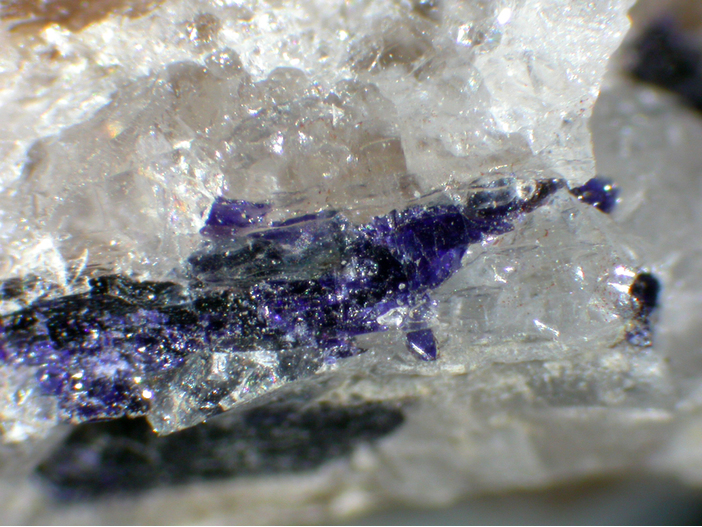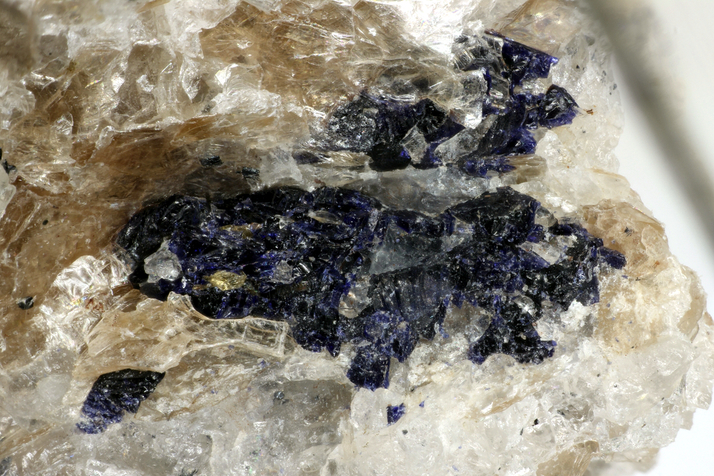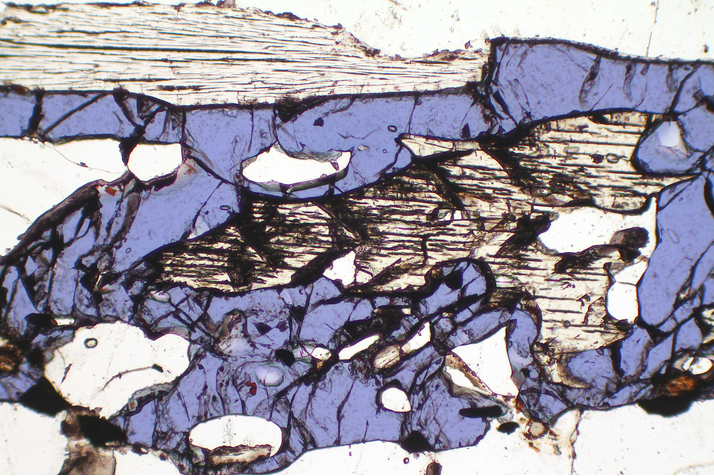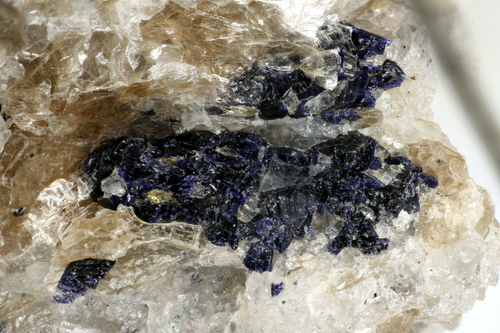Yoderite
A valid IMA mineral species
This page is currently not sponsored. Click here to sponsor this page.
About Yoderite
Formula:
Mg(Al,Fe3+)3(SiO4)2O(OH)
Colour:
Deep purple to dark violet, green (rare)
Lustre:
Vitreous, Greasy
Hardness:
6
Specific Gravity:
3.39
Crystal System:
Monoclinic
Name:
Named in 1959 by Duncan Mckie in honor of Hatten Schuyler Yoder, Jr. [March 20, 1921 Cleveland, Ohio, USA - August 2, 2003 Bethesda, Maryland, USA], petrologist, Director of the Geophysical Laboratory, Carnegie Institution of Washington (USA).
A major phase in quartz-kyanite-talc schist formed under conditions of ~10 kbar H2O pressure and 800 °C.
Unique Identifiers
Mindat ID:
4363
Long-form identifier:
mindat:1:1:4363:8
GUID
(UUID V4):
(UUID V4):
4d44bdc5-8b2d-4d73-817f-1b16b5a29c74
IMA Classification of Yoderite
Approved
IMA Formula:
(MgAl3)(MgAl)Al2O2(SiO4)4(OH)2
Classification of Yoderite
9.AF.25
9 : SILICATES (Germanates)
A : Nesosilicates
F : Nesosilicates with additional anions; cations in [4], [5] and/or only [6] coordination
9 : SILICATES (Germanates)
A : Nesosilicates
F : Nesosilicates with additional anions; cations in [4], [5] and/or only [6] coordination
52.2.2b.3
52 : NESOSILICATES Insular SiO4 Groups and O,OH,F,H2O
2 : Insular SiO4 Groups and O, OH, F, and H2O with cations in [4] and >[4] coordination
52 : NESOSILICATES Insular SiO4 Groups and O,OH,F,H2O
2 : Insular SiO4 Groups and O, OH, F, and H2O with cations in [4] and >[4] coordination
16.19.9
16 : Silicates Containing Aluminum and other Metals
19 : Aluminosilicates of Fe and Mg
16 : Silicates Containing Aluminum and other Metals
19 : Aluminosilicates of Fe and Mg
Mineral Symbols
As of 2021 there are now IMA–CNMNC approved mineral symbols (abbreviations) for each mineral species, useful for tables and diagrams.
| Symbol | Source | Reference |
|---|---|---|
| Yod | IMA–CNMNC | Warr, L.N. (2021). IMA–CNMNC approved mineral symbols. Mineralogical Magazine, 85(3), 291-320. doi:10.1180/mgm.2021.43 |
Pronunciation of Yoderite
Pronunciation:
| Play | Recorded by | Country |
|---|---|---|
| Jolyon Ralph | United Kingdom |
Physical Properties of Yoderite
Vitreous, Greasy
Transparency:
Transparent
Colour:
Deep purple to dark violet, green (rare)
Hardness:
6 on Mohs scale
Cleavage:
Distinct/Good
{001}
{001}
Parting:
[001] good
{100} poor
{100} poor
Density:
3.39 g/cm3 (Measured) 3.33 g/cm3 (Calculated)
Optical Data of Yoderite
Type:
Biaxial (+)
RI values:
nα = 1.689 - 1.691 nβ = 1.691 - 1.693 nγ = 1.712 - 1.715
2V:
Measured: 25° to 30°, Calculated: 34° to 36°
Max Birefringence:
δ = 0.023 - 0.024

Image shows birefringence interference colour range (at 30µm thickness)
and does not take into account mineral colouration.
and does not take into account mineral colouration.
Surface Relief:
High
Dispersion:
weak to moderate
Pleochroism:
Visible
Comments:
Blue - prussian blue, indigo, olive green
Green - Green, pale yellow, yellow
Color - alpha, beta, gamma
Green - Green, pale yellow, yellow
Color - alpha, beta, gamma
Chemistry of Yoderite
Mindat Formula:
Mg(Al,Fe3+)3(SiO4)2O(OH)
Common Impurities:
Ti,Mn,H2O,P
Chemical Analysis
Oxide wt%:
| 1 | 2 | |
|---|---|---|
| P2O5 | 0.29 % | 0.37 % |
| SiO2 | 36.56 % | 36.33 % |
| TiO2 | 0.06 % | 0.06 % |
| Al2O3 | 43.52 % | 43.50 % |
| Ga2O3 | 0.01 % | 0.01 % |
| V2O3 | 0.01 % | 0.01 % |
| Cr2O3 | 0.01 % | 0.06 % |
| Fe2O3* | 4.95 % | 4.50 % |
| FeO* | 0.44 % | 0.65 % |
| MnO | 0.52 % | % |
| MgO | 11.90 % | 12.06 % |
| SrO | 0.01 % | 0.01 % |
| K2O | 0.01 % | % |
| F | 0.01 % | % |
| H2O (by stoichiometry) | 2.74 % | 2.73 % |
| -O=F | -0.00 % | % |
| NiO | % | 0.01 % |
| Na2O | % | 0.01 % |
| Total: | 101.04 % | 100.31 % |
Empirical formulas:
| Sample ID | Empirical Formula |
|---|---|
| 1 | (Mg1.93Mn2+0.05Fe2+0.02)(Al5.57Fe3+0.39Fe2+0.03Ti0.01)O2[Si0.99P0.01O4]4(OH)2.00 |
| 2 | (Mg1.96Fe2+0.04)(Al5.59Fe3+0.37Fe2+0.02Ti0.01Cr0.01)O2[Si0.99P0.01O4]4(OH)2.00 |
Sample references:
| ID | Locality | Reference | Notes |
|---|---|---|---|
| 1 | Mautia Hill, Kongwa, Kongwa District, Dodoma Region, Tanzania | deep indigo/purple yoderite rimming orange kyanite, along with quartz and talc, in classic eclogite-facies "whiteschist" assemblage. EPMA analysis Fe measured as FeO, so Fe3+ calculated from charge balance; H2O calculated by stoichiometry. | |
| 2 | " " | green yoderite as large patches intergrown within a single large splintery anthophyllite crystal, along with patchy talc. This assemblage differs from the classic kyanite+talc "whiteschist" assemblage, although it presumably experienced similar P-T conditions. EPMA analysis Fe measured as FeO, so Fe3+ calculated by charge balance. H2O calculated by stochiometry. |
Crystallography of Yoderite
Crystal System:
Monoclinic
Class (H-M):
2/m - Prismatic
Space Group:
P21/m
Cell Parameters:
a = 8.02 Å, b = 5.81 Å, c = 7.25 Å
β = 104.91°
β = 104.91°
Ratio:
a:b:c = 1.38 : 1 : 1.248
Unit Cell V:
326.45 ų (Calculated from Unit Cell)
Z:
1
Morphology:
Anhedral grains, bladed or lathlike crystals to 12mm
Crystal Structure
Load
Unit Cell | Unit Cell Packed
2x2x2 | 3x3x3 | 4x4x4
Unit Cell | Unit Cell Packed
2x2x2 | 3x3x3 | 4x4x4
Show
Big Balls | Small Balls | Just Balls | Spacefill
Polyhedra Off | Si Polyhedra | All Polyhedra
Remove metal-metal sticks
Big Balls | Small Balls | Just Balls | Spacefill
Polyhedra Off | Si Polyhedra | All Polyhedra
Remove metal-metal sticks
Display Options
Black Background | White Background
Perspective On | Perspective Off
2D | Stereo | Red-Blue | Red-Cyan
Black Background | White Background
Perspective On | Perspective Off
2D | Stereo | Red-Blue | Red-Cyan
View
CIF File Best | x | y | z | a | b | c
CIF File Best | x | y | z | a | b | c
Rotation
Stop | Start
Stop | Start
Labels
Console Off | On | Grey | Yellow
Console Off | On | Grey | Yellow
Data courtesy of the American Mineralogist Crystal Structure Database. Click on an AMCSD ID to view structure
| ID | Species | Reference | Link | Year | Locality | Pressure (GPa) | Temp (K) |
|---|---|---|---|---|---|---|---|
| 0000855 | Yoderite | Higgins J B, Ribbe P H, Nakajima Y (1982) An ordering model for the commensurate antiphase structure of yoderite American Mineralogist 67 76-84 |  | 1982 | 0 | 293 | |
| 0000856 | Yoderite | Higgins J B, Ribbe P H, Nakajima Y (1982) An ordering model for the commensurate antiphase structure of yoderite American Mineralogist 67 76-84 |  | 1982 | 0 | 293 | |
| 0009274 | Yoderite | Fleet S G, Megaw H D (1962) The crystal structure of yoderite Acta Crystallographica 15 721-728 |  | 1962 | Mautia Hill, Tanzania | 0 | 293 |
CIF Raw Data - click here to close
X-Ray Powder Diffraction
Powder Diffraction Data:
| d-spacing | Intensity |
|---|---|
| 3.50 Å | (100) |
| 3.03 Å | (80) |
| 2.61 Å | (60) |
| 2.00 Å | (60) |
| 1.82 Å | (60) |
| 3.23 Å | (50) |
| 3.19 Å | (50) |
Geological Environment
Paragenetic Mode(s):
| Paragenetic Mode | Earliest Age (Ga) |
|---|---|
| Stage 5: Initiation of plate tectonics | <3.5-2.5 |
| 40 : Regional metamorphism (greenschist, amphibolite, granulite facies) |
Geological Setting:
Major phase in kyanite-quartz-talc schist ~10 kb water pressure, 800 °C.
Type Occurrence of Yoderite
Place of Conservation of Type Material:
Geological Survey of Tanzania, JH 2563/2, JH 2563/14; National Museum of Natural History, Washington, D.C., USA, 137854.
Associated Minerals at Type Locality:
Reference:
McKie D, Radford A J (1959) Yoderite, a new hydrous magnesium iron alumino-silicate from Mautia Hill, Tanganyika. Mineralogical Magazine 32, 282-307
Other Language Names for Yoderite
Common Associates
Associated Minerals Based on Photo Data:
Related Minerals - Strunz-mindat Grouping
| 9.AF. | Chegemite | Ca7(SiO4)3(OH)2 |
| 9.AF. | Barwoodite | Mn2+6Nb5+(SiO4)2O3(OH)3 |
| 9.AF. | Jingwenite-(Y) | YAlV4+(SiO4)O2(OH)2 |
| 9.AF.05 | Sillimanite | Al2(SiO4)O |
| 9.AF.05 | Xenolite | Al10Si8O31 |
| 9.AF.10 | Andalusite | Al2(SiO4)O |
| 9.AF.10 | Kanonaite | Mn3+Al(SiO4)O |
| 9.AF.15 | Kyanite | Al2(SiO4)O |
| 9.AF.20 | Mullite | Al4+2xSi2-2xO10-x |
| 9.AF.20 | Krieselite | Al2(GeO4)F2 |
| 9.AF.23 | Boromullite | Al9BSi2O19 |
| 9.AF.30 | Magnesiostaurolite | Mg(Mg,Li)3(Al,Mg)18Si8O44(OH)4 |
| 9.AF.30 | Staurolite | Fe2+2Al9Si4O23(OH) |
| 9.AF.30 | Zincostaurolite | Zn2Al9Si4O23(OH) |
| 9.AF.35 | Topaz | Al2(SiO4)(F,OH)2 |
| 9.AF.40 | Norbergite | Mg3(SiO4)F2 |
| 9.AF.45 | Alleghanyite | Mn2+5(SiO4)2(OH)2 |
| 9.AF.45 | Chondrodite | Mg5(SiO4)2F2 |
| 9.AF.45 | Reinhardbraunsite | Ca5(SiO4)2(OH,F)2 |
| 9.AF.45 | Kumtyubeite | Ca5(SiO4)2F2 |
| 9.AF.45 | Hydroxylchondrodite | Mg5(SiO4)2(OH)2 |
| 9.AF.50 | Humite | Mg7(SiO4)3F2 |
| 9.AF.50 | Manganhumite | (Mn2+,Mg)7(SiO4)3(OH)2 |
| 9.AF.50 | Unnamed (Ca-analogue of Humite) | Ca7(SiO4)4F2 |
| 9.AF.50 | Fluorchegemite | Ca7(SiO4)3F2 |
| 9.AF.50 | Unnamed (OH-analogue of humite) | Mg7(SiO4)3(OH)2 |
| 9.AF.55 | Clinohumite | Mg9(SiO4)4F2 |
| 9.AF.55 | Sonolite | Mn2+9(SiO4)4(OH)2 |
| 9.AF.55 | Hydroxylclinohumite | Mg9(SiO4)4(OH)2 |
| 9.AF.60 | Leucophoenicite | Mn2+7(SiO4)3(OH)2 |
| 9.AF.65 | Ribbeite | Mn2+5(SiO4)2(OH)2 |
| 9.AF.70 | Jerrygibbsite | Mn2+9(SiO4)4(OH)2 |
| 9.AF.75 | Franciscanite | Mn2+6(V5+,◻)2(SiO4)2(O,OH)6 |
| 9.AF.75 | Örebroite | Mn2+3(Sb5+,Fe3+)(SiO4)(O,OH)3 |
| 9.AF.75 | Welinite | Mn2+6(W6+,Mg)2(SiO4)2(O,OH)6 |
| 9.AF.75 | Scorticoite | Mn6(Sb,◻)Σ2(SiO4)2O3(OH)3 |
| 9.AF.80 | Ellenbergerite | Mg6(Mg,Ti,Zr,◻)2(Al,Mg)6Si8O28(OH)10 |
| 9.AF.85 | Chloritoid | (Fe2+,Mg,Mn2+)Al2(SiO4)O(OH)2 |
| 9.AF.85 | Magnesiochloritoid | MgAl2(SiO4)O(OH)2 |
| 9.AF.85 | Ottrélite | (Mn2+,Fe2+,Mg)Al2(SiO4)O(OH)2 |
| 9.AF.90 | Poldervaartite | CaCa[SiO3(OH)](OH) |
| 9.AF.90 | Olmiite | CaMn2+[SiO3(OH)](OH) |
| 9.AF.95 | Pilawite-(Y) | Ca2Y2Al4(SiO4)4O2(OH)2 |
Other Information
Health Risks:
No information on health risks for this material has been entered into the database. You should always treat mineral specimens with care.
Internet Links for Yoderite
mindat.org URL:
https://www.mindat.org/min-4363.html
Please feel free to link to this page.
Please feel free to link to this page.
Search Engines:
External Links:
Mineral Dealers:
References for Yoderite
Localities for Yoderite
Locality List
 - This locality has map coordinates listed.
- This locality has map coordinates listed.
 - This locality has estimated coordinates.
ⓘ - Click for references and further information on this occurrence.
? - Indicates mineral may be doubtful at this locality.
- This locality has estimated coordinates.
ⓘ - Click for references and further information on this occurrence.
? - Indicates mineral may be doubtful at this locality.
 - Good crystals or important locality for species.
- Good crystals or important locality for species.
 - World class for species or very significant.
(TL) - Type Locality for a valid mineral species.
(FRL) - First Recorded Locality for everything else (eg varieties).
- World class for species or very significant.
(TL) - Type Locality for a valid mineral species.
(FRL) - First Recorded Locality for everything else (eg varieties).
All localities listed without proper references should be considered as questionable.
Tanzania (TL) | |
| Mineralogical Magazine 1963 33 : 635-645 +2 other references |
Zimbabwe | |
| Johnson et al. (1998) |
Quick NavTopAbout YoderiteUnique IdentifiersIMA Classification Classification Mineral SymbolsPronunciation Physical Properties Optical Data Chemistry Chemical AnalysisCrystallography Crystal StructureX-Ray Powder DiffractionGeological EnvironmentType Occurrence Other LanguagesCommon AssociatesStrunz-MindatOther InformationInternet Links References Localities Locality List






 symbol to view information about a locality.
The
symbol to view information about a locality.
The 



Mautia Hill, Kongwa, Kongwa District, Dodoma Region, Tanzania